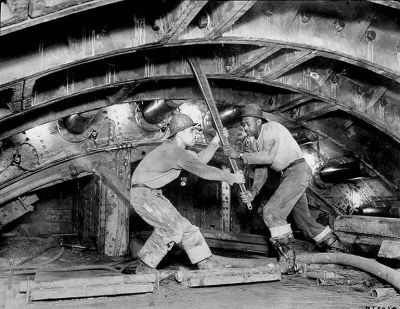
Queens Midtown Tunnel, linking Manhattan to Long Island City. Sandhogs tighten a bolt. Photo Michael Bobco, Somach Photo Svc. Feb. 26, 1939. published 11-15-2010 by wnyc.org.
Though the slang term refers mainly to such workers beneath The Big Apple, beginning about 1872 with toil on the foundation for the Brooklyn Bridge, urban tunneling, mining, and related efforts have been and are done around the world and in all manner of relatively safe to extremely perilous conditions.
How dangerous early sandhog work could be is suggested by the fact that excavations for the Brooklyn Bridge had to be stopped several feet short of reaching bedrock due to the high number of men with "the Bends" among workers struggling in very high pressure to keep the river out of where they were digging. In an extraordinary later incident, in 1916, a worker was forced out through the side of his tunnel by extreme air pressure. His body was propelled through 12 feet of surrounding riverbed and "spit out" at the water's surface with such force he rose on a geyser four stories high. Amazingly, he survived with no major injury.
Workers put in the sewers beneath London starting with intersecting tunnels begun in 1859. Tunnels beneath Paris were started in the 13th Century. A limestone quarry tunnel under Naours, France, dates back to the 3rd Century and has been used at various time as a refuge against invaders. Ancient Rome had a network of catacombs. No doubt early humans used tunneling techniques to expand their cave and cavern dwellings for both living space and grain storage. Ancient Babylon had used tunnels for irrigation, and, approximately 2200 BC, a tunnel was created there that went under the Euphrates River and connected the royal palace with a temple of that period.
 Queens Midtown Tunnel, linking Manhattan to Long Island City. Sandhogs tighten a bolt. Photo Michael Bobco, Somach Photo Svc. Feb. 26, 1939. published 11-15-2010 by wnyc.org. |
What would in time be called the London Underground was begun by construction workers in the mid-19th Century and opened with the Metropolitan Railway in 1863. Gas-lit carriages were hauled by steam powered locomotives.
Tunnels were famously built by slave labor in Germany during World War II at great cost in loss of life. The resulting excavations and hardened structures were used for ammunition storage, vital industrial operations, and aircraft manufacture and parts, as well as the protection from bombing of submarines and rocketry weapons.
Modern tunneling techniques still at times rely on workers with explosives, shovels, and pickaxes, but these efforts are greatly supplemented by such huge devices as the Tunnel Boring Machine (TBM), as was deployed for the Eurorail "Chunnel" under the English Channel, linking France and Britain.
Besides the Brooklyn Bridge, some of the prominent U.S. construction projects by sandhogs or other urban mining and tunneling workers include the Holland Tunnel, George Washington Bridge, and the Lincoln Tunnel, in NYC.
By far the greatest successful U.S. led excavation project under extreme conditions occurred with the building of the Panama Canal, linking the Atlantic and Pacific Oceans. This involved 25 times the extent of the modern Chunnel's removal of rock, mud, and other debris. Work progressed despite terribly severe circumstances. At its height, the building and removal of material were progressing at a rate equivalent to one Chunnel every three and a half months. Tens of thousands of workers, largely Black labor, were involved. The U.S. project was begun in 1904 and completed in 1916. Over 75,000 men and women contributed their sweat to this one endeavor. Due to tropical diseases, accidents, and simply the rigor of the jobs under harsh conditions, an estimated 5600 people lost their lives in the process. Over 20,000 had already died in the prior, ultimately unsuccessful, French canal operation.
Underground efforts were a factor in the completion of Hoover Dam, begun in 1931 and finished in 1936. Additional notable U.S. underground construction projects: the Boston Big Dig, completed in 2007 at a total cost estimated at over $22 billion; and Chicago's Deep Tunnel system to control floodwater from Lake Michigan, still not finished, but with major portions done as of this year. The estimated cost is $4 billion.
Not so much in the news but likely no less impressive are over 120 underground U.S. military facilities, Deep Underground Military Bases and Structures (DUMBS).
Hats off to the many great men and a few women who have in the past made possible, and still are contributing to, these marvelous constructions. Most of the results have been terrifically useful and beneficial, even if on balance at least a few have proven to be not quite so smart. This latter reality does not take away from the courage, dedication, and stamina of our amazing underground builders.
*Per Google, large watertight chambers, open at the bottom from which the water is kept out by air pressure and in which construction work may be carried out under water. Many thanks to Google as well for ready access to most of the other details in this little essay.